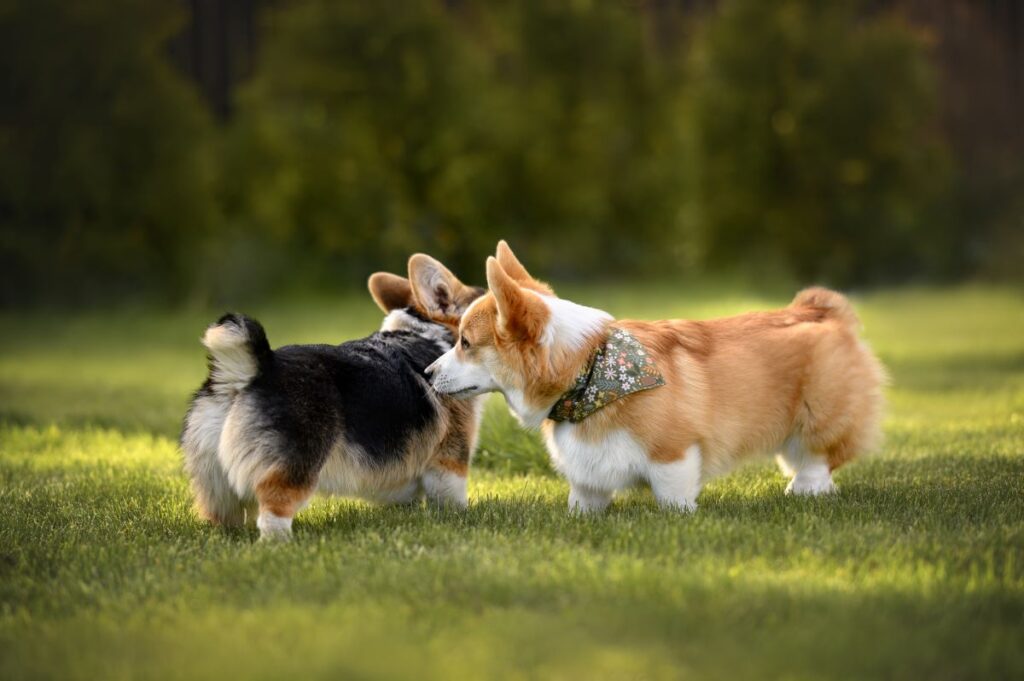Humans are verbal creatures and we extend this communication to our dogs, giving commands and praise through mainly vocal cues. As a result, we often fail to realize how much of dog-to-dog communication depends on other senses, including scent and body language. By comparison, we humans are nose-blind and deaf to the more subtle canine cues. Understanding how your dog is communicating with other dogs can be a vital tool in avoiding inter-dog conflict and keeping your dog safe and happy.
Table of Contents:
- How do dogs communicate?
- Scent Clues
- Body Language
- Vocalization
- Key Communication Situations
- The bottom line
How Do Dogs Communicate?
So how does your dog communicate with its canine companions? You can’t miss the moments when dogs strike up a volley of barking, yet vocalization is just a small slice of a dog’s language tools. The many other conversations happening at the dog park often exist outside of our immediate perception. Dogs are social creatures through and through. Canine ancestors lived, hunted, raised and protected young in family packs with complex social ties and hierarchies. As most of us know, cohabitation is challenging and can lead to conflict, so canines use their own form of language to maintain social dynamics and peace. This “language” is quite different from ours, instead relying on three main forms:
Scent Clues
A lot of information is being exchanged between two pups that is hidden from human eyes. Because a dog’s communication relies so heavily on scent — their olfactory sense of smell is 10,000 – 100,000 times stronger than ours — this means dogs are able to pick up chemical signals in body odors that give insights and context into another dog’s gender, age, social standing, and level of emotional arousal.
Body Language
Dogs can interpret a lot from each other based on body language alone, with different body parts telling different stories. Our dogs are highly socially attuned to subtle inflections shared by these signals. According to a 2018 study titled Communication in Dogs, “Dogs engage in visual communication by modifying different parts of their body; in tactile communication; and also in auditory and olfactory communication, with vocalizations and body odors, respectively.”
- Tail wagging: Perhaps the most obvious and easy clue to a dog’s temper, but it’s also one of the most misunderstood. A wagging tail just means a happy dog, right? Not exactly. A dog’s tail wagging is actually an indicator of emotional arousal rather than happiness, indicating your dog is alert to a situation. The speed and position of the tail tells another dog a lot more: faster wags indicate higher excitement levels. A very low tail indicates fear and submission, while a high tail can suggest confidence or even dominance. Just because your dog is wagging its tail in a social situation, does not guarantee they are happy. Pay attention to stiff, tight wags or a tucked, low tail as signs of potential fear and conflict ahead.
- Posture: The way a dog holds itself reveals a lot about its emotional state to the dogs around it. Dog dynamics can often hinge on dominance and submission. Signs of submission include lowered body and tail, even rolling over to expose the underbelly, with cringing mannerisms and attempts to appear smaller and less threatening. This dog is experiencing a measure of fear and stress. The dominant player, meanwhile, will attempt to appear as large as possible, approaching other dogs face-on with head and weight shifted forward.
- Fur: Believe it or not, your dog’s fur can send a message to other dogs. The technical name ‘piloerection’ refers to the way your dog might fluff itself up in moments of emotional arousal, almost like when we humans get goosebumps. This phenomenon is also known as “raised hackles,” an involuntary reflex triggered by the sympathetic nervous system’s fight-or-flight response. It helps your dog appear bigger and more intimidating during a moment of stress — and can sometimes, though not always, preempt an aggressive outburst.
- Ears: Dogs have over a dozen muscles in their ears that give them the ability to move into various positions in response to social and environmental cues. The most extreme positions, pinned back or pricked far forward are the most clear indicators of a dog displaying intense emotional arousal. Ears laid back tend to tell other dogs: “I’m uncomfortable and afraid,” while ears forward communicate an intense degree of excitement and focus.
- Face & eyes: Much like us, dogs depend on facial expressions for clues to another dog’s emotional state. (In fact, the human-dog bond has led to research that suggests dogs produce more facial expressions in our presence.) A happy and content dog will display a relaxed mouth (closed or slightly open), slow panting, raised eyebrows, neutral ears, and sometimes a “smiling” mouth. Flattened ears, sideways or “whale eyes,” and repeated nose licking and yawning are signs of appeasement and submission, indicating the dog may feel vulnerable. The most obvious facial cues among dogs are lips drawn back and teeth bared in a snarl — a universal sign of aggression.
Vocalization
Like people, some dogs are naturally more talkative than others, and certain breeds tend to be more vocal. Huskies and Samoyeds are famously chatty, while the Basenji dog will rarely utter a bark. Most dogs use a range of sounds to communicate with each other.
- Barking: Generally, dogs bark among themselves to express emotion, such as excitement or fear. Barking can also be situational, like an alert system used to express danger. When interpreting your dog’s bark, it’s best to frame it in the context of body language, pitch and intensity, and tail position to get a better sense of your dog’s emotions.
- Growling: This sound is instinctively understood by humans and dogs alike as a warning that can escalate to an act of aggression, motivated by anger, fear, panic or possessiveness. It sends a clear message to other dogs, typically paired with clear-cut defensive body language. On the flip side, playful growling is also common among dogs — think of games of tug of war and wrestling among puppies and the showboating growling that accompanies it. Play growling tends to come in short, slow pulses. The sound, context and body language should give you and other dogs a clear idea of which kind of growl it is!
- Whining: Puppies learn to use whining as a communication tool to get the attention of their mother and/or caretaker when they have an unmet need, such as hunger, thirst or comfort. Whining can also indicate emotional distress. In this form, whining can sound like crying, such as a dog suffering from separation stress or physical discomfort.
- Howling: Howling is likely a behavior left over from dogs’ wolf-like ancestors. Some dogs will never give this deep-throated vocal expression, while breeds like hounds and huskies are known for their tendency to have a good sing. Howling may be used toward other dogs to establish their presence or territory, while others may simply be compelled by howls from other dogs, sirens, or even songs.
Key Communication Situations
Meet & Greet
How dogs “talk” to each other upon meeting usually indicates whether they will end up as friends or foes. This usually begins with the funny and familiar “butt sniffing” routine. While comical, it’s the most efficient way for dogs to get familiar with each other. Thanks to their highly sophisticated noses, dogs are able to detect chemical compounds that reveal another dog’s gender, health, and even mood. In short, when your dog sniffs another dog’s behind, it’s gathering a brief biography of its new potential friend.
Playtime
After a successful introduction, the fun can begin. Play allows dogs to establish hierarchies and strengthen social bonds, as well as stay physically agile. This behavior begins early in life when puppies begin wrestling with their littermates. One of the most endearing and recognizable dog poses is the “play bow,” where a dog places its forelegs and chest on the ground and raises its rump to invite another dog (or human!) to engage in a game. Wrestling, rolling, bounding, tugging, and soft-mouthed biting are all performed within the boundaries of gentle play learned in puppyhood, with dogs generally taking turns to play the mock aggressor. The nuances of playtime are a subtle demonstration of social dominance and submission in dog hierarchies. Dogs that are too boisterous or pushy in play may provoke a reprimand in the form of snaps and snarls.
Conflict
Dogs fight for a variety of reasons: often out of fear or to protect family, territory, or food. Some dogs will go on the offensive when they feel threatened, have poor emotional regulation, or are experiencing discomfort or distress. Dogs will communicate their escalating stress and aggression through tense body language, posture, scent, and vocalizations like growling and snarling. This acts as a warning to other dogs to back down. Acts of aggression are typically a last resort.
The bottom line
Language allows humans to be very specific communicators. Dog communication, meanwhile, is more general, reflecting an emotional state in a given moment through a variety of sensory clues. Just like people, some dogs are better communicators than others. Nonetheless, time spent interacting with others is important to help your dog maintain social and communication skills and develop canine connections. It’s worth observing and learning your dog’s social aptitude to predict how they might respond to situations with other dogs. Like us, a stressed dog or a dog experiencing discomfort may naturally be more vocal and less effective at communication.
Sources:
https://www.ncbi.nlm.nih.gov/pmc/articles/PMC6116041/
https://www.thesprucepets.com/dog-language-understanding-dog-talk-2804565
https://www.rover.com/blog/how-dogs-communicate-with-each-other/
https://blog.tryfi.com/dog-communication/
https://www.akc.org/expert-advice/advice/how-to-read-dog-body-language/








